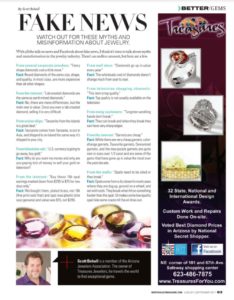Fake News: Watch out for these myths and misinformation about jewelry.
Watch out for these myths and misinformation about jewelry.
By Scott Bohall
With all the talk on news and Facebook about fake news, I think it’s time to talk about myths and misinformation in the jewelry industry. There’s an endless amount, but here are a few.
From several corporate jewelers: “Fancy shape diamonds cost a little more.”
Fact: Round diamonds of the same size, shape, and quality, in most sizes, are more expensive than all other shapes.
From the internet: “Lab created diamonds are the same as earth mined diamonds.”
Fact: No, there are many differences, but the main one is value. Once you own a lab created diamond, selling it is very difficult.
From cruise ships: “Tanzanite from the islands is a great deal.”
Fact: Tanzanite comes from Tanzania, is cut in Asia, and shipped to an island the same way it is shipped to your city.
From television ads: “U.S. currency is going to go away, buy gold.”
Fact: Why do you want my money and you are paying lots of money to sell your gold on television?
From the internet: “Buy these 18k opal earrings marked down from $295 to $15 for two days only.”
Fact: We bought them, plated brass, not 18k (fine print said that) and opal was plastic (site says genuine) and value was $15, not $295.
From mall store: “Diamonds go up in value every year.”
Fact: The wholesale cost of diamonds don’t change much from year to year.
From television shopping channels: “This item is top quality.”
Fact: Top quality is not available on the television.
From many customers: “Tungsten wedding bands don’t break.”
Fact: They can break and when they break they can have very sharp edges.
From the internet: “Garnets are cheap.”
Fact: While there are very cheap garnets, color-change garnets, Tsavorite garnets, Demantoid garnets, and the new purple garnets are quite rare in sizes over 1/2 carat and are some of the gems that have gone up in value the most over the past decade.
From the malls: “Opals need to be oiled or they break.”
Fact: Opals come from a dry desert in most cases where they are dug up, ground on a wheel, and set with tools. They break when hit on something harder than the opal. Oil makes some low quality opal hide some cracks till the oil dries out.
Related posts
Leave a Comment
You must be logged in to post a comment.







